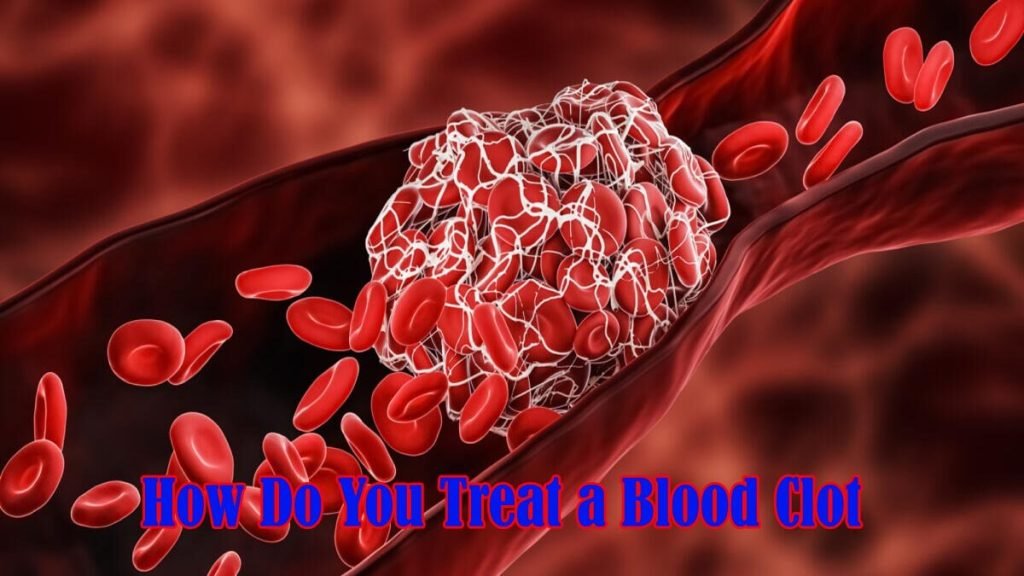How Do You Treat a Blood Clot? Blood clots can be a serious medical condition that requires prompt and appropriate treatment. If left untreated, blood clots can lead to complications such as deep vein thrombosis (DVT) or even life-threatening conditions like pulmonary embolism. In this article, we will explore various treatment options for blood clots and provide valuable insights into managing this condition effectively.
Introduction
When a blood clot forms within a blood vessel, it can disrupt the normal flow of blood and pose serious health risks. Prompt and appropriate treatment is essential to prevent complications and ensure the well-being of the individual affected by a blood clot.
Understanding Blood Clots
Blood clots are gel-like clumps of blood that form when certain components in the blood stick together. They can occur in both arteries and veins, and the location and severity of the clot determine the appropriate treatment approach. Arterial blood clots typically form in the arteries supplying the heart or brain, while venous blood clots develop in the veins.
Diagnosing Blood Clots
To determine if a blood clot is present, healthcare professionals may employ various diagnostic methods. These include physical examinations, medical history assessments, blood tests, ultrasounds, computed tomography (CT) scans, magnetic resonance imaging (MRI), or venography. Accurate diagnosis is crucial for identifying the appropriate treatment options.

Medication-Based Treatments
Medication-based treatments are commonly used to manage blood clots effectively. They aim to prevent the clot from growing larger, reduce the risk of new clots forming, and prevent existing clots from breaking loose and causing further complications.
Anticoagulant Therapy
Anticoagulant medications, also known as blood thinners, are frequently prescribed to patients with blood clots. These medications work by inhibiting the blood’s ability to clot, thereby preventing the formation of new clots and reducing the risk of existing clots becoming larger. Examples of commonly used anticoagulant medications include heparin and warfarin.
Thrombolytic Therapy
Thrombolytic therapy involves the use of medications known as thrombolytics or clot busters. These medications are administered intravenously and work by dissolving the blood clot, restoring blood flow in the affected area. Thrombolytic therapy is typically reserved for severe cases or when there is an immediate risk to the patient’s life.
Surgical Interventions
In some cases, surgical interventions may be necessary to treat blood clots effectively. These procedures aim to remove or bypass the clot, restoring normal blood flow and preventing further complications.
Catheter-Directed Thrombolysis
Catheter-directed thrombolysis is a minimally invasive procedure that involves the insertion of a catheter into the affected blood vessel. Medications are then delivered directly to the clot through the catheter, dissolving it and restoring blood flow.
Inferior Vena Cava Filters
Inferior vena cava (IVC) filters are small devices that can be implanted in the vena cava, the large vein that carries blood from the lower body to the heart. These filters trap blood clots before they can travel to the lungs or other vital organs, reducing the risk of pulmonary embolism.
Compression Stockings
Compression stockings, also known as support stockings or compression socks, are elastic garments that are worn on the legs. They exert gentle pressure, helping to improve blood flow and prevent the formation of blood clots. Compression stockings are particularly useful for individuals who are at risk of developing blood clots, such as those who have undergone surgery or have limited mobility.
Lifestyle Changes
Making certain lifestyle changes can also play a crucial role in the treatment and prevention of blood clots. These changes are aimed at reducing risk factors and improving overall vascular health.
Diet and Exercise
Maintaining a healthy diet and engaging in regular physical activity are essential for managing blood clots. A balanced diet rich in fruits, vegetables, lean proteins, and whole grains can help reduce the risk of blood clot formation. Regular exercise improves circulation, strengthens the cardiovascular system, and lowers the risk of blood clots.
Managing Underlying Health Conditions
Managing underlying health conditions, such as obesity, high blood pressure, diabetes, and high cholesterol, is crucial in preventing the occurrence of blood clots. Following prescribed treatments, taking medications as directed, and making lifestyle modifications can significantly reduce the risk of developing blood clots.
Prevention of Blood Clots
Prevention is always better than cure when it comes to blood clots. By following a few simple steps, individuals can reduce their risk of developing blood clots.
Conclusion
Blood clot treatment requires a multifaceted approach, combining medication-based treatments, surgical interventions, lifestyle changes, and preventive measures. Prompt diagnosis and appropriate treatment can help prevent complications and improve outcomes for individuals affected by blood clots.
FAQs About How Do You Treat a Blood Clot
Are blood clots life-threatening?
Blood clots can be life-threatening, especially if they travel to the lungs and cause a pulmonary embolism. Prompt medical attention is crucial.
Can blood clots be prevented?
Yes, blood clots can be prevented by maintaining a healthy lifestyle, managing underlying health conditions, and following preventive measures recommended by healthcare professionals.
How long does it take to recover from a blood clot?
The recovery time for a blood clot depends on various factors, such as the location and severity of the clot, the chosen treatment, and individual health factors. It is best to consult with a healthcare professional for personalized guidance.
Can blood clots recur?
Yes, blood clots can recur. It is important to follow the prescribed treatment plan and take preventive measures to minimize the risk of recurrence.
Can natural remedies help in treating blood clots?
While some natural remedies may have blood-thinning properties, it is crucial to consult with a healthcare professional before using them, as they can interact with medications or have unintended side effects.
In conclusion, timely and appropriate treatment is crucial when dealing with blood clots. By understanding the available treatment options, making lifestyle changes, and following preventive measures, individuals can effectively manage this condition and reduce the risk of complications. Remember to consult with a healthcare professional for personalized advice and guidance.


